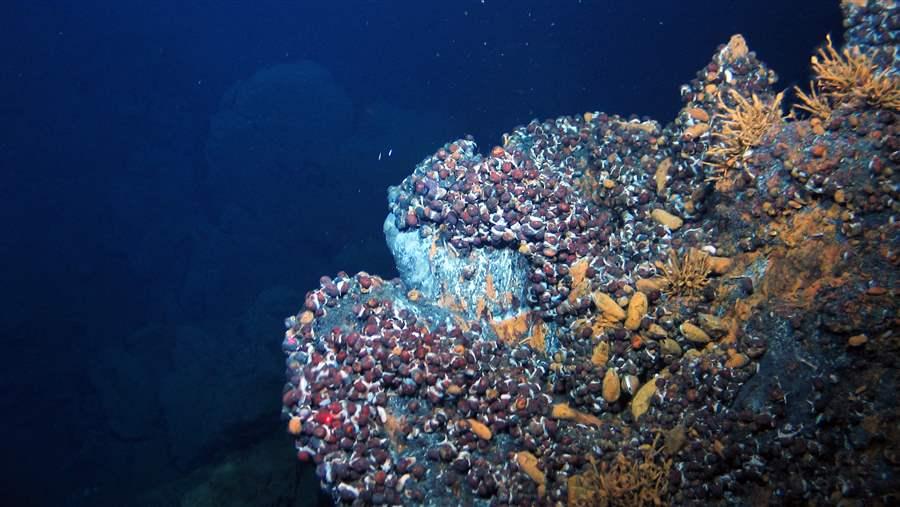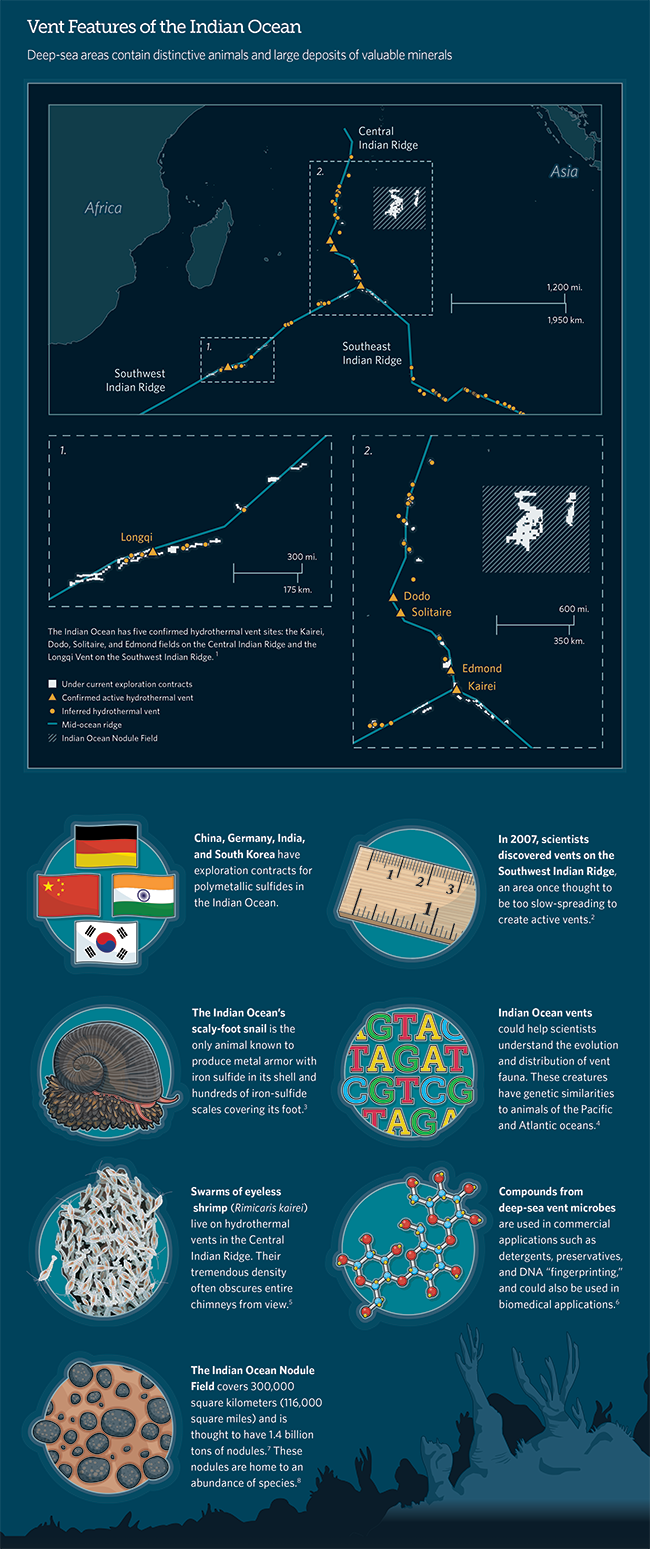The Indian Ocean
Diverse ecosystems harbor distinctive deep-sea life and sought-after minerals
Overview
Vast abyssal plains, mountain chains, and seamounts cover the bottom of the Indian Ocean. Each area is home to life forms suited to its particularities—and each also holds valuable minerals that could be removed through seabed mining.
Hydrothermal vents spew superheated, mineral-laden water into their surroundings that, when cooled, forms towers containing copper, cobalt, nickel, zinc, gold, and rare earth elements. These minerals are essential to modern economies. The vent zones are biologically rich as well, supporting mussels, stalked barnacles, scaly-foot snails, and a variety of microbes with potential biomedical and industrial applications.
Atop the Indian Ocean’s abyssal plains are more than a billion potato-size nodules with rich concentrations of manganese, copper, cobalt, and nickel. On and near the nodules, wildlife—such as sponges, sea cucumbers, and fish—has evolved to flourish in the deep cold and darkness. Seabed mining is expected to have a significant and long-lasting impact on these deep-sea ecosystems. Mining equipment would remove or degrade habitats, sediment plumes could smother nearby life, and noise and light could harm the unique species that have evolved in order to live here.
The International Seabed Authority (ISA) was established by the Law of the Sea treaty to manage seabed mining in areas beyond national jurisdiction while protecting the marine environment. The ISA is drafting regulations to accomplish these objectives with rules on where and how seabed mining could occur. Its regional environmental management plans, which could designate large no-mining zones, are a vital element of its efforts to protect marine biodiversity.
Endnotes
- Kentaro Nakamura and Ken Takai, “Indian Ocean Hydrothermal Systems: Seafloor Hydrothermal Activities, Physical and Chemical Characteristics of Hydrothermal Fluids, and Vent-Associated Biological Communities,” in Subseafloor Biosphere Linked to Hydrothermal Systems, eds. Jun-ichiro Ishibashi, Kyoko Okino, and Michinari Sunamura (Tokyo: Springer, 2015), https://link.springer.com/chapter/10.1007/978-4-431-54865-2_12; InterRidge, “InterRidge Vents Database Ver. 3.4: Vent Fields,” accessed Feb. 5, 2018, https://vents-data.interridge.org.
- Woods Hole Oceanographic Institution, “Scientists Discover First Seafloor Vents on Ultraslow-Spreading Ridge,” accessed Feb. 5, 2018, http://www.whoi.edu/main/news-releases/2007?tid=3622&cid=26088.
- Chong Chen et al., “The ‘Scaly-Foot Gastropod’: A New Genus and Species of Hydrothermal Vent-Endemic Gastropod (Neomphalina: Peltospiridae) From the Indian Ocean,” Journal of Molluscan Studies 81, no. 3 (2015): 322–34, https://doi.org/10.1093/mollus/eyv013.
- Hiromi Watanabe and Girish Beedessee, “Vent Fauna on the Central Indian Ridge,” in Subseafloor Biosphere Linked to Hydrothermal Systems, eds. Jun-ichiro Ishibashi, Kyoko Okino, and Michinari Sunamura (Tokyo: Springer, 2015), https://link.springer.com/chapter/10.1007/978-4-431-54865-2_16.
- Ibid.
- Woods Hole Oceanographic Institute, “Bacteria at Hydrothermal Vents,” accessed April 6, 2018, https://divediscover.whoi.edu/hottopics/bacteria-at-hydrothermal-vents.
- Thomas Kuhn et al. “Composition, Formation, and Occurrence of Polymetallic Nodules,” in Deep-Sea Mining: Resource Potential, Technical and Environmental Considerations, ed. Rahul Sharma (New York: Springer, 2017), 56.
- Qianhui Zeng et al., “Deep-Sea Metazoan Meiofauna From Polymetallic Nodule Area in the Central Indian Ocean Basin,” Marine Biodiversity 48, no. 1 (2017): 1–11, https://rd.springer.com/article/10.1007/s12526-017-0778-0; Ravail Singh et al., “Nematode Communities Inhabiting the Soft Deep-Sea Sediment in Polymetallic Nodule Fields: Do They Differ From Those in the Nodule-Free Abyssal Areas?” Marine Biology Research 12, no. 4 (2016): 345–59, http://www.tandfonline.com/doi/full/10.1080/17451000.2016.1148822?src=recsys&.








